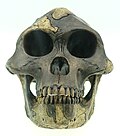Kenyanthropus platyops
Kenyanthropus platyops is an extinct hominid species discovered in Lake Turkana, Kenya in 1999. It was by Justus Erus, who was part of Meave Leakey's team.[1]
| Kenyanthropus platyops Temporal range: Pliocene
| |
|---|---|
| Scientific classification | |
| Kingdom: | |
| Phylum: | |
| Class: | |
| Order: | |
| Family: | |
| Subfamily: | |
| Genus: | Kenyanthropus
|
| Binomial name | |
| †Kenyanthropus platyops Leakey et al., 2001
| |
The fossil is 3.5 to 3.2 million years old. It has a broad flat face with a toe bone that suggests it probably walked upright. Teeth are intermediate between typical human and typical ape forms.
Leakey proposed that the fossil represents an entirely new hominine genus.[2] Others classify it as a separate species of Australopithecus, Australopithecus platyops, and still others interpret it as an individual of Australopithecus afarensis.
If some palaeoanthropologists are correct, Kenyanthropus may not even represent a valid taxon. The specimen is so distorted by matrix-filled cracks that meaningful morphological characteristics are next to impossible to assess with confidence.
Kenyanthropus Platyops Media
Location of Lomekwi, on the western shore of Lake Turkana, Kenya
Reconstruction of H. rudolfensis KNM-ER 1470, which resembles Kenyanthropus KNM-WT 40000
Kenyanthropus was contemporary with A. afarensis ("Lucy" above)
References
- ↑ Kenyanthropus platyops
- ↑ Leakey, Meave G.; Spoor, Fred; Brown, Frank H.; Gathogo, Patrick N.; Kiarie, Christopher; Leakey, Louise N.; McDougall, Ian (2001). "New hominin genus from eastern Africa shows diverse middle Pliocene lineages". Nature. 410 (6827): 433–440. Bibcode:2001Natur.410..433L. doi:10.1038/35068500. PMID 11260704. S2CID 4409453.
Other websites
![]() Media related to Kenyanthropus platyops at Wikimedia Commons
Media related to Kenyanthropus platyops at Wikimedia Commons



